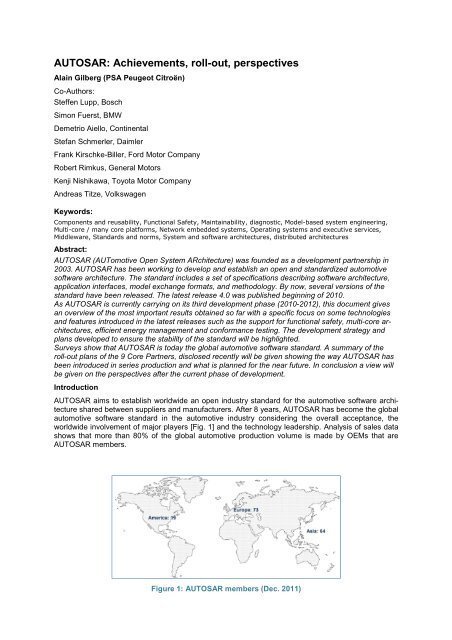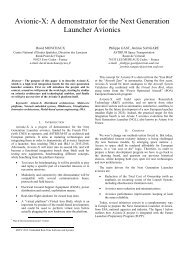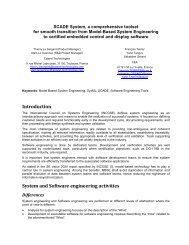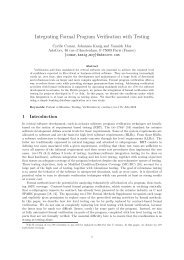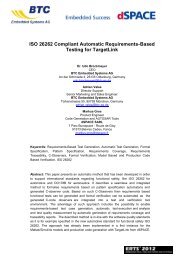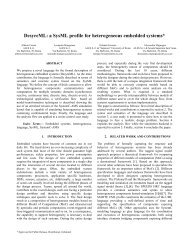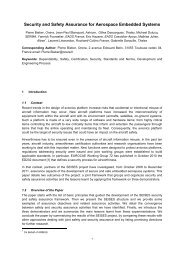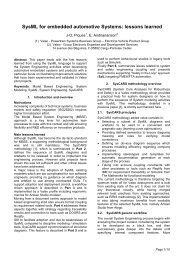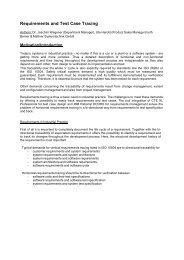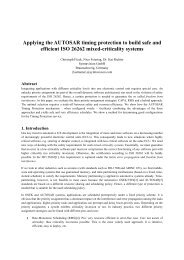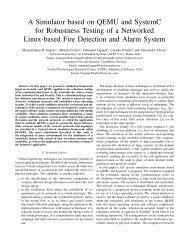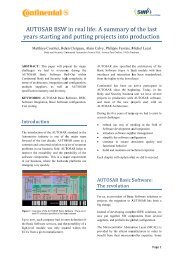AUTOSAR: Achievements, roll-out, perspectives
AUTOSAR: Achievements, roll-out, perspectives
AUTOSAR: Achievements, roll-out, perspectives
You also want an ePaper? Increase the reach of your titles
YUMPU automatically turns print PDFs into web optimized ePapers that Google loves.
<strong>AUTOSAR</strong>: <strong>Achievements</strong>, <strong>roll</strong>-<strong>out</strong>, <strong>perspectives</strong><br />
Alain Gilberg (PSA Peugeot Citroën)<br />
Co-Authors:<br />
Steffen Lupp, Bosch<br />
Simon Fuerst, BMW<br />
Demetrio Aiello, Continental<br />
Stefan Schmerler, Daimler<br />
Frank Kirschke-Biller, Ford Motor Company<br />
Robert Rimkus, General Motors<br />
Kenji Nishikawa, Toyota Motor Company<br />
Andreas Titze, Volkswagen<br />
Keywords:<br />
Components and reusability, Functional Safety, Maintainability, diagnostic, Model-based system engineering,<br />
Multi-core / many core platforms, Network embedded systems, Operating systems and executive services,<br />
Middleware, Standards and norms, System and software architectures, distributed architectures<br />
Abstract:<br />
<strong>AUTOSAR</strong> (AUTomotive Open System ARchitecture) was founded as a development partnership in<br />
2003. <strong>AUTOSAR</strong> has been working to develop and establish an open and standardized automotive<br />
software architecture. The standard includes a set of specifications describing software architecture,<br />
application interfaces, model exchange formats, and methodology. By now, several versions of the<br />
standard have been released. The latest release 4.0 was published beginning of 2010.<br />
As <strong>AUTOSAR</strong> is currently carrying on its third development phase (2010-2012), this document gives<br />
an overview of the most important results obtained so far with a specific focus on some technologies<br />
and features introduced in the latest releases such as the support for functional safety, multi-core architectures,<br />
efficient energy management and conformance testing. The development strategy and<br />
plans developed to ensure the stability of the standard will be highlighted.<br />
Surveys show that <strong>AUTOSAR</strong> is today the global automotive software standard. A summary of the<br />
<strong>roll</strong>-<strong>out</strong> plans of the 9 Core Partners, disclosed recently will be given showing the way <strong>AUTOSAR</strong> has<br />
been introduced in series production and what is planned for the near future. In conclusion a view will<br />
be given on the <strong>perspectives</strong> after the current phase of development.<br />
Introduction<br />
<strong>AUTOSAR</strong> aims to establish worldwide an open industry standard for the automotive software architecture<br />
shared between suppliers and manufacturers. After 8 years, <strong>AUTOSAR</strong> has become the global<br />
automotive software standard in the automotive industry considering the overall acceptance, the<br />
worldwide involvement of major players [Fig. 1] and the technology leadership. Analysis of sales data<br />
shows that more than 80% of the global automotive production volume is made by OEMs that are<br />
<strong>AUTOSAR</strong> members.<br />
Figure 1: <strong>AUTOSAR</strong> members (Dec. 2011)
In the context of the growing complexity of automotive electronic architectures, the need to build a<br />
common architecture became stringent for a variety of reasons, among which:<br />
• The high number of proprietary solutions regarding ECU software infrastructure was a barrier<br />
to flexibility and optimization of embedded electronic architectures,<br />
• On the contrary, an open architecture can enable software reuse, reallocation and smooth<br />
evolutions limiting therefore re-development and validation costs,<br />
• The effort to develop a standard software architecture can easily be communalized in the automotive<br />
industry as it belongs to a non-competitive area,<br />
• A common model based methodology improves the efficiency in designing complex systems<br />
with multiple partners.<br />
The standard comprises a set of specifications describing the basic software infrastructure, application<br />
software interfaces, methods and templates. Let’s focus on the <strong>AUTOSAR</strong> layered software architecture<br />
which consists of Basic Software Modules and a middleware (Run Time Environment: RTE). It<br />
provides to the application software an abstraction of the micro-cont<strong>roll</strong>er and of the Electronic Control<br />
Unit (ECU). The <strong>AUTOSAR</strong> basic software (BSW) [Fig. 2] plays a key role in the architecture providing<br />
to the application software a standardized set of infrastructure functions (e.g. memory services, communication,<br />
or diagnostics). On top of this architecture, the RTE achieves the independency between<br />
hardware and application software components (SW-Cs).<br />
Today the BSW can be regarded as a Commercial-Off-The-Shelf product. Several <strong>AUTOSAR</strong> members<br />
offer BSW implementations, covering the different <strong>AUTOSAR</strong> releases and a broad variety of<br />
typical automotive embedded hardware. During the evolution of the standard several features have<br />
been introduced, which enable less resource consuming BSW implementations. In parallel the BSW<br />
vendors have been optimizing their implementations in general. Consequently, the suitability of AU-<br />
TOSAR for low resource systems has improved significantly.<br />
Figure 2: <strong>AUTOSAR</strong> Software Architecture<br />
SW-Cs are integrated on top of the RTE, due to this hardware independency they can be re-used in<br />
different ways:<br />
• A supplier can integrate them on vehicles of different car manufacturers,<br />
• A car manufacturer can reuse them in electronic components of different suppliers,<br />
• An ECU can integrate SW-C from multiple suppliers,<br />
• Finally SW-Cs can be part of several product generations.<br />
The on-going development of <strong>AUTOSAR</strong> products by the member companies provides a unique feedback<br />
loop into the development of the standard itself. This allows fast and pragmatic improvements.<br />
The reusability of software has already been experienced in major developments and it has resulted in<br />
substantial savings in the overall development costs.<br />
<strong>AUTOSAR</strong> Timeline<br />
<strong>AUTOSAR</strong><br />
Software<br />
Component<br />
Interface<br />
Standard<br />
Software<br />
Interfaces:<br />
VFB & RTE<br />
relevant<br />
RTE<br />
relevant<br />
BSW<br />
relevant<br />
Possible interfaces<br />
inside<br />
Basic Software<br />
(which are<br />
not specified<br />
within <strong>AUTOSAR</strong>)<br />
Application<br />
Software<br />
Component<br />
<strong>AUTOSAR</strong><br />
Interface<br />
Standardized<br />
Interface<br />
Operating<br />
System<br />
Standardized<br />
Interface<br />
Actuator<br />
Software<br />
Component<br />
<strong>AUTOSAR</strong><br />
Interface<br />
Sensor<br />
Software<br />
Component<br />
<strong>AUTOSAR</strong> Runtime Environment (RTE)<br />
Standardized<br />
<strong>AUTOSAR</strong><br />
Interface<br />
Services<br />
Standardized<br />
Interface<br />
Basic Software<br />
ECU-Hardware<br />
<strong>AUTOSAR</strong><br />
Software<br />
..............<br />
Standardized<br />
Interface<br />
Application<br />
Software<br />
Component<br />
<strong>AUTOSAR</strong> is experiencing its third phase in standardizing the software architecture for electronic control<br />
units in vehicles. First major sets of specifications (R2.x) were produced at the end of its Phase I<br />
[Fig. 3]. During the Phase II the main releases 3.x and 4.0 were made available.<br />
Currently, <strong>AUTOSAR</strong> Phase III concentrates on maintenance and selective enhancements of the<br />
standard in order to ease further exploitation. For the ongoing further developments of the release 4.0,<br />
the focus is set on maintenance and on the introduction of concepts fulfilling market needs. Meanwhile<br />
2 of 8 <strong>AUTOSAR</strong> ERTS 2012_Final.docx-<br />
<strong>AUTOSAR</strong><br />
Interface<br />
Standardized<br />
Interface<br />
Communication<br />
Standardized<br />
Interface<br />
<strong>AUTOSAR</strong><br />
Interface<br />
ECU<br />
Abstraction<br />
Standardized<br />
Interface<br />
Microcont<strong>roll</strong>er<br />
Abstraction<br />
<strong>AUTOSAR</strong><br />
Interface<br />
<strong>AUTOSAR</strong><br />
Interface<br />
Complex<br />
Drivers
a new minor release 3.2 has been developed to fulfill short-term market needs. While being backwards<br />
compatible with the release 3.1, the release 3.2 contains a well-defined set of extensions. Currently,<br />
the maintenance of releases 2.1, 3.0 and 3.1, where very few requests for changes are identified,<br />
is performed by the mean of a LOKI (List of Known Issues).<br />
<strong>Achievements</strong> of Phase I and Phase II<br />
Figure 3: <strong>AUTOSAR</strong> Timeline<br />
<strong>AUTOSAR</strong> PHASE 1 (2003-2006) - The main purpose of the Phase I was to achieve a complete set of<br />
the specifications of architecture, methodology and templates.<br />
Release 1.0 of the <strong>AUTOSAR</strong> specifications is related to parts of the basic software below runtime<br />
environment (RTE) level. This was followed by a “proof of concept” period. The findings from this period<br />
then have resulted in further refinements being made to the specifications.<br />
Release 2.x focused on the completion of Basic Software (BSW) components and the RTE:<br />
• Release 2.0 is a complete set of specifications including the configuration concept.<br />
• Release 2.1 is an update of Release 2.0 with the <strong>out</strong>come from implementation and validation<br />
of BSW modules on hardware platforms.<br />
Both, releases 2.0 and 2.1, are in use by several <strong>AUTOSAR</strong> members for series productions.<br />
<strong>AUTOSAR</strong> PHASE 2 (2007-2009) - Three releases were planned for <strong>AUTOSAR</strong> Phase II, providing a<br />
continuous improvement of the specifications and introducing new concepts. Additionally, the <strong>out</strong>come<br />
from the validation at the end of Phase I and the feedback from all <strong>AUTOSAR</strong> stakeholders were incorporated.<br />
Release 3.0 was published early 2008 on the <strong>AUTOSAR</strong> web site. It includes a large number of improvements,<br />
for example the harmonization of the ECU wake-up and the network start-up, and corrections<br />
with respect to the previous releases.<br />
Release 3.1 was dedicated to the incorporation of On-Board-Diagnostics (OBD) regulations support<br />
mechanisms.<br />
At the end of Phase II, the release 4.0 integrated many new features – e.g. related to functional safety<br />
or communication. The release 4.0 was delivered by the end of 2009 after its validation. Conformance<br />
test specifications followed in an update of release 4.0 by beginning of 2011.<br />
In order to cover all vehicle functionalities, <strong>AUTOSAR</strong> has started working on two new car domains in<br />
the area of Application Interfaces during Phase II: Telematics/Multimedia/HMI and Occupants and<br />
Pedestrian Safety Systems. Moreover, Powertrain, Chassis, and Body and Comfort interfaces have<br />
performed their first steps of integration. All in all <strong>AUTOSAR</strong> interfaces of many application software<br />
functions (e.g. central locking, power train control, adaptive cruise control, etc.) were standardized in<br />
Phase II.<br />
<strong>AUTOSAR</strong> Phase III status<br />
1<br />
2<br />
3<br />
Phase I Phase II Phase III<br />
Development of the architecture and methodology<br />
Rel. 1.0 Rel. 2.0/2.1 Rel. 3.0/3.1<br />
Rel. 4.0<br />
Selective enhancement<br />
2004 2005 2006 2007 2008 2009 2010 2011 2012<br />
PLANNING STRATEGY - After having developed the standard, specifying mature software architecture,<br />
<strong>AUTOSAR</strong> is selectively enhancing the standard by adding new features. Nevertheless, it was<br />
crucial to find a pragmatic approach, defining the right balance between innovation and stability. For<br />
this reason, the development partnership decided to enhance release 4.0 in a continuous way, preserving<br />
backwards compatibility towards deployed releases instead of publishing a new major release<br />
end of 2012.<br />
3 of 8 <strong>AUTOSAR</strong> ERTS 2012_Final.docx-<br />
Rel. 3.2<br />
Rel. 4.0<br />
Maintenance and support of the exploitation<br />
*Loki = List of known issues<br />
Rel. 2.1/3.0/3.1 (Loki*)<br />
Rel. 4.0<br />
Rel. 3.2
All Members were invited to propose concepts, which could form the set of specific additions. The<br />
proposed concepts have been elaborated further on in order to get the maturity for implementation.<br />
The approval for implementation is currently being given either for the next revision 4.0.4 planned end<br />
of 2012 or on a later stage depending on the market needs, the strategic value, the impact and expected<br />
workload.<br />
Additionally, maintenance of the different releases used for series production is ongoing in order to<br />
support the distribution of <strong>AUTOSAR</strong> into the market. Consequently, <strong>AUTOSAR</strong> developed release<br />
3.2 based on market needs during the first half of Phase III.<br />
Figure 4: Project Roadmap <strong>AUTOSAR</strong> Phase III<br />
NEW MINOR RELEASE 3.2 - During the implementation of <strong>AUTOSAR</strong> in series products, the market<br />
proposed to add certain improvements to the existing release 3.1, in order to ease migration to AU-<br />
TOSAR. In order to fulfill these market needs regarding content and timing, <strong>AUTOSAR</strong> provided the<br />
new minor Release 3.2.<br />
The release 3.2 is kept backward compatible to the release 3.1. It contains a well-defined set of extensions<br />
focusing on the communication stack and additional corrections. As major new functionality “partial<br />
networking” is supported. The first revision of release 3.2 was published end of April 2011.<br />
RELEASE 4.0.4 –This revision supports new technologies and extends existing functions. Enhancements<br />
include concepts such as:<br />
• Basic Software: extended hardware support, further capabilities to the release 4.0 Ethernet<br />
functions, means for efficient energy management, enhanced use multi-core microcont<strong>roll</strong>ers,<br />
interoperability between <strong>AUTOSAR</strong> and automotive multimedia applications, partial networking,<br />
etc.<br />
• Methodology & Templates: support of iterative development, distributed development, configuration<br />
profiles, <strong>AUTOSAR</strong> textual language, etc.<br />
• Application Interfaces: improvements and extensions to support further applications with a priority<br />
set on well-established and often used application interfaces.<br />
The release 4.0.4 will be delivered end of 2012.<br />
Some concepts introduced in <strong>AUTOSAR</strong> latest releases<br />
The introduction of new features in the Release 4.0 is motivated by the requests of the market either<br />
regarding new regulations or technology evolutions.<br />
FUNCTIONAL SAFETY – In order to support automotive safety-related applications <strong>AUTOSAR</strong> has<br />
introduced substantial safety features in the basic software and runtime environment since its release<br />
4.0. These features have been designed considering the standard ISO 26262 related to functional<br />
safety in automotive electronics and recently published. Some of them are summarized in this<br />
section.<br />
• Program flow monitoring is checking the correct execution of embedded system software. It is<br />
focusing on control flow errors, which cause a divergence from the valid program sequence<br />
during the execution of the application. An incorrect program flow occurs if one or more program<br />
instructions are processed either in the incorrect sequence or are not even processed at<br />
all. Control flow errors can lead to data corruption, process crashes, or fault propagation.<br />
4 of 8 <strong>AUTOSAR</strong> ERTS 2012_Final.docx-
• Memory partitioning and user/supervisor-mode features enable groups of SW-Cs to run in<br />
separate memory partitions. Moreover, user-mode partitions are executed in CPU user mode;<br />
they have therefore limited access to CPU’s special function registers and supervisor mode<br />
instructions. Illegal memory access will be detected and prevented by the memory protection<br />
unit (MPU) hardware. The faulty partition will then shut down. All software components in the<br />
partition can also be restarted. Creating protection boundaries around groups of software<br />
components (SW-C) this mechanism enables the freedom of interference between SW-Cs<br />
with different safety integrity levels (ASIL) on the same ECU.<br />
• <strong>AUTOSAR</strong> provides also end-to-end (E2E) communication protection for safety-related data<br />
exchange between software components running even on different microcont<strong>roll</strong>ers. This<br />
mechanism detects faults in communication, regardless whether the source is the hardware or<br />
software. The protection mechanisms are implemented in the end-to-end library, they keep the<br />
software component implementation independent from the dedicated communication link<br />
• Finally, <strong>AUTOSAR</strong> provides measures for mitigating hardware faults. This includes various<br />
modules for testing hardware, e.g. RAM test and/or core test, and checking stored data via<br />
CRCs.<br />
MULTI-CORE - Latest embedded multi-core micro cont<strong>roll</strong>ers provide a better computing power with<br />
reduced energy consumption. This increase in computing power is necessary in order to meet the<br />
needs of future control software and further integration of functionality. However multiple cores’ computing<br />
power can only be taken advantage of, if the software is designed accordingly.<br />
<strong>AUTOSAR</strong> specifications of the runtime environment (RTE) and operating system (OS) has been extended<br />
by multi-core specific features. The RTE hides the multi-core details from the application, so<br />
the application software can be developed independent of multi-core issues in a reusable fashion.<br />
The distribution of application software among cores is supported by the <strong>AUTOSAR</strong> methodology and<br />
hence by the tool chain. Adding further flexibility w.r.t. load balancing and basic software distribution is<br />
planned for the future.<br />
PARTIAL NETWORKING - <strong>AUTOSAR</strong> has worked on concepts addressing the reduction of electrical<br />
power consumption in vehicles, based on the fact that not all ECUs need to be active in the same time<br />
(e.g. seat control or park assistant functions). The first concept – partial networking – is incorporated in<br />
the release 3.2 and in the release 4.0.<br />
Partial networking [Fig. 5] enables the suspension and resumption of communication activity of individual<br />
ECUs within an active communication bus. This allows the implementation of strategies that can<br />
put ECUs related to inactive vehicle functions into a low power mode or off, even as other ECUs continue<br />
to communicate on the same bus channel. Setting unneeded ECUs to low power modes reduces<br />
the overall electrical consumption, thus increasing the fuel economy and reducing CO2 emissions.<br />
The development of partial networking deals with challenges like synchronized and selective ECU<br />
wake-up, new transceiver hardware capabilities and new network message filtering concepts. With<br />
partial networking, <strong>AUTOSAR</strong> partners and members will benefit from standardized, high quality and<br />
interoperable solutions enabling the development of new technologies for energy efficient electronic<br />
architectures.<br />
Figure 5: Basic principle of partial networking<br />
5 of 8 <strong>AUTOSAR</strong> ERTS 2012_Final.docx-
Further concepts are considered for next revisions regarding the local management of energy consumption<br />
reduction in single ECUs that can enter in a low consumption while communication on networks<br />
remains enabled or reduce the number of their own active components.<br />
CONFORMANCE TESTING - In order to ensure a smooth integration of basic software into a vehicle<br />
architecture, an <strong>AUTOSAR</strong> conformance test system has been defined. Conformance tests specifications<br />
has been released in the Release 4.0 addressing most basic software modules. The conformance<br />
test process is kept optional and can be conducted either by third or first party conformance test<br />
agencies. Alternatively a product supplier can declare by itself the conformance of its products to the<br />
<strong>AUTOSAR</strong> specifications.<br />
The feed-back from conformance test development process has been very important improving the<br />
testability of the specifications of basic software modules, but the granularity of tests at module level<br />
has been questioned. Actually, optimizations of implementations of the basic software stack can require<br />
the bundling of individual modules, bundles remaining <strong>AUTOSAR</strong> compliant. A black box approach<br />
at ECU level is therefore more valuable.<br />
For that reason, further revisions of <strong>AUTOSAR</strong> will include acceptance tests focusing on application<br />
and bus level. The Basic Software will be regarded as black box. By that, an OEM will be able to decide<br />
on the acceptance of a supplier’s platform. The acceptance test is a further evolution of AU-<br />
TOSAR’s conformance test system and will replace the conformance tests on single Basic Software<br />
modules.<br />
<strong>AUTOSAR</strong> <strong>roll</strong>-<strong>out</strong> in series production<br />
During the 3° <strong>AUTOSAR</strong> Open Conference (May 2011), t he Core partners disclosed their <strong>roll</strong>-<strong>out</strong><br />
plans, presenting how <strong>AUTOSAR</strong> will be used in the near future in series projects.<br />
As the development time is usually ab<strong>out</strong> four years, all current developments will be brought into<br />
series by 2016. Many OEMs and suppliers rely on the standard and are introducing <strong>AUTOSAR</strong> in a<br />
wide range of applications. 25 million ECUs, produced by the <strong>AUTOSAR</strong> Core Partners in 2011 will be<br />
based on the <strong>AUTOSAR</strong> architecture, while 300 million are currently planned for 2016 [Fig. 6].<br />
Figure 6: <strong>AUTOSAR</strong> ECUs planned production by Core Partners<br />
ROLL-OUT STRATEGIES: The <strong>AUTOSAR</strong> implementation of the Core Partners is always timegraded.<br />
While almost all Core Partners are already using <strong>AUTOSAR</strong> basic software and parts of the<br />
methodology in series production, the usage of the complete methodology and application interfaces<br />
will follow at a later point in time. The utilization of the basic software is thus always the first step of<br />
<strong>AUTOSAR</strong> implementation. Before the <strong>AUTOSAR</strong> standard was introduced, some companies were<br />
using their own proprietary basic software solution. Switching from proprietary software to standardized<br />
software architecture offers cost and capacity benefits for all involved in automotive electronics<br />
development.<br />
In a second step, the whole <strong>AUTOSAR</strong> methodology will be applied. While some of the Core Partners<br />
are already using several templates in series, most of the Core Partners plan to use all other templates<br />
at a later stage.<br />
As a third step, the <strong>AUTOSAR</strong> application interfaces will be introduced. <strong>AUTOSAR</strong> is making great<br />
progress in standardizing the most commonly used application interfaces, the aim being to ensure the<br />
6 of 8 <strong>AUTOSAR</strong> ERTS 2012_Final.docx-
eusability of applications based on them and to allow data exchange between them. These standardized<br />
application interfaces will enter then series production.<br />
The Core Partners showed different ways in introducing <strong>AUTOSAR</strong> in series production [Fig.7]. Some<br />
of the car makers prefer the complete conversion of electronic architecture while others focus on dedicated<br />
domains or ECUs. Tiers 1 and also some car makers are following the strategy of their development<br />
partners.<br />
Figure 7: Core Partners preferred <strong>roll</strong>-<strong>out</strong> strategy<br />
RELEASES IN USE: As the <strong>roll</strong>-<strong>out</strong> by the Core partners started from 2008, many releases are currently<br />
in use for series projects including the release 2.x which were the very first ones. At the moment<br />
Releases 2.1 and 3.x are the main ones being launched by the Core Partners [Fig. 8]. Starting in<br />
2013, Release 4.0 will be brought into series together with Release 3.2 and will become the main<br />
streams. By offering and maintaining two releases at the same time for series development and production,<br />
<strong>AUTOSAR</strong> ensures continuity and a smooth change between releases.<br />
Figure 8: Releases launch by Core Partners (1st use)<br />
LICENSE MODE: Another topic was the preferred license model for basic software, Core Partners<br />
Tiers 1 and some OEMs are making their own development while others OEM either buy their own<br />
license to software vendors or let it to Tiers1.<br />
Figure 9: Core Partners Preferred License model<br />
7 of 8 <strong>AUTOSAR</strong> ERTS 2012_Final.docx-
Conclusion<br />
The current development phase sees <strong>AUTOSAR</strong> working on the selective enhancement of Release<br />
3.x and Release 4.0 in order to ensure a reliable and future-oriented architecture and methodology.<br />
During this process, the development partnership focuses on backwards compatibility at all times.<br />
Furthermore, the maintenance of current releases used for series development and production plays<br />
an important role in supporting the implementation of the standard for all members.<br />
Since the current <strong>AUTOSAR</strong> development contract ends by the end of 2012, the <strong>AUTOSAR</strong> Core<br />
Partners will set up a new contract starting beginning of 2013. The standard will be maintained, new<br />
hardware mechanisms will be supported and further market driven concepts will be specified.<br />
<strong>AUTOSAR</strong> follows the principle 'Cooperate on standards, compete on implementation', so each company<br />
has to follow its own strategy on the basis of the roadmap for its product lines. The <strong>AUTOSAR</strong><br />
standard is already being used in series production, and this has been a major success for AU-<br />
TOSAR. Also, many <strong>AUTOSAR</strong> members are currently working on volume platforms in which the majority<br />
of ECUs are based on <strong>AUTOSAR</strong>. As the advantages of <strong>AUTOSAR</strong> are very convincing, the<br />
coming years will see a lot more launches of car models with <strong>AUTOSAR</strong> ECUs on board<br />
By now <strong>AUTOSAR</strong> has become ‘the’ global standard for electronic infrastructure software and methodology.<br />
It is an enabling technology to manage the growing complexity of automotive electronics and<br />
to improve cost-efficiency with<strong>out</strong> making any compromise with respect to quality.<br />
References<br />
<strong>AUTOSAR</strong> On the Road (Convergence, Detroit, 2008)<br />
<strong>AUTOSAR</strong> – a Worldwide standard Current developments, <strong>roll</strong>-<strong>out</strong> and <strong>out</strong>look (VDI, Baden Baden,<br />
2011)<br />
<strong>AUTOSAR</strong> Report: The Progress in Software Standardization Activities (CAR ELE, Tokio, 2010)<br />
<strong>AUTOSAR</strong> Update (IESF, Detroit, 2011)<br />
3 rd <strong>AUTOSAR</strong> Open Conference (Frankfurt, 2011)<br />
<strong>AUTOSAR</strong> Website: www.autosar.org<br />
8 of 8 <strong>AUTOSAR</strong> ERTS 2012_Final.docx-


